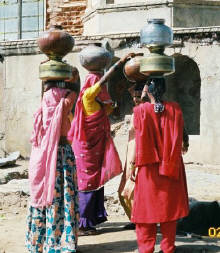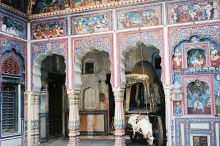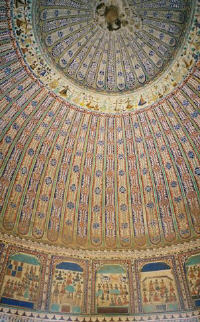In Search of Nomads
Rajasthan, India
“I want to meet the Banjaras,” I passionately requested, inaccurately referring to Rajasthan’s nomadic people. “I’ve always been fascinated by gypsy life, and now that I’m here in Rajasthan, I want to experience a part of it.”
Rajesh was somewhat taken aback. “Uhhhmmm…there is a Lohar (blacksmith) camp a few kilometers out of Nawalgarh,” he said. “We’ll have to visit them early in the day before they leave for work.”
The Guadaliya Lohars, a nomadic people, trace their origins back to a Rajput tribe in Marwar. When the Mughals invaded the fort of Chittor, the Lohars left their native land, pledging to return only after it was recovered. Instead, they took up a nomadic life for centuries. Despite the government’s repeated offers to resettle them, they continue to wander throughout Rajasthan in their ornate metal carts and colorful tribal garbs, stopping only to attend to the villagers’ metallurgic needs.
Momentarily appeased, I settled down to enjoy my delicious dinner of kaddhi (curried buttermilk) and sangri. Returning to my homeland after being away for over a decade, I wanted to experience everything – to look at this country with the admiring eye of an outsider, but with the innate understanding of an insider. Rajasthan embodied the paradox that was India. Valiant warriors and their elegant Rajputanis (Rajput women) coexisted harmoniously with proud, hardworking peasants and industrious merchants. The wealthiest of India emerged from this land, as did the poorest of the poor. Ballads were sung about the courage of their women, and yet today, female children struggle for survival. Rich palaces and mansions housed royalty for centuries while gypsies wandered carefree in the shifting desert sands. It was the prevalence of these nomads in Rajasthan’s Thar Desert – their vibrant culture and feisty souls – that captivated my restless spirit.
I made my hasty departure for Shekhawati on the eve of the Holi festival, leaving behind the inebriated revelers in the dust and grime of congested Jaipur. In the 15th century, Rao Shekha, a scion of the Kachhwaha family of Jaipur, established the Shekhawati region in northeast Rajasthan. Strategically located on the Silk Road, the region amassed great wealth through taxes. The wealthy Marwaris (people of Shekhawati) built numerous schools, baoris (wells), reservoirs, temples and havelis (mansions), all of which have added to, rather than detract from, Shekhawati’s bucolic charm.


At the baori in Nawalgarh
![]()
![]()
The next morning at the crack of dawn, sitting astride Rajesh’s motorcycle, we began our search for nomads in the sandy countryside littered with quaint hamlets and millet fields. It was a crisp morning, the rustic beauty of Shekhawati intoxicating. Womenfolk, laughing at local gossip, were returning from the fields after completing their morning ablutions. Men yawned as they donned their dhotis and turbans. I was exhilarated to take the same path that millions of camel and gypsy caravans had taken before me.
The Guadaliya Lohars had set up camp near the riverbed some 15 km south east of Nawalgarh. We rode through wavering fields on sand paved roads. Hundreds of khejri trees stood proud, showing off their prickly beauty to admiring passersby. The khejri tree is the quintessential Rajasthani flora. Its deep root system helps it thrive in this drought-plagued land. Every part of this tree is used – thorny twigs to protect crops, wood for furniture and fuel, dried leaves for fodder and building roofs, and sangri, the nutritious bean-shaped fruit, for nourishment.
Khejri trees aplenty, but Lohars nowhere to be found, we halted. Rajesh, baffled, scratched his head.
“I promise you they were right here a few days ago,” he said, perplexed. “They must have just moved.”
Then, looking at my dejected face, he suggested, “We are very close to Parsurampura. Someone there might know where the Lohars went.”
To get to the small village of Parsurampura, we had to cross a dry riverbed, or rather, according to Rajesh, a conglomeration of six sandy beds of ephemeral streams originating from the nearby Aravali hills. Maneuvering the motorcycle through the sandy beds proved to be challenging, and finally we gave up and crossed the wide riverbed on foot. By the time we reached the tiny village, it was close to 8 am. Mothers in their multicolored ghaghra-cholis (skirt-tops) and brilliantly dyed odhnis (veils) were sending reluctant children off to school to conquer the world of words. Turbaned men, on camel or on foot, were on their way to the fields to breathe life into barren lands. Cows and goats moved out of the way while we zigzagged over the narrow cobbled streets, dogs invariably barking at our feet.
“There is a beautiful temple I want to show you,” Rajesh said. “The paintings there are some of the best of Lord Krishna.”
The small Gopinathji Mandir was built in 1742 C.E. by Thakur Sardul Singh, a local chieftain who had thrown out the Nawab of Fatepur.
“The painter finished painting this temple with his legs,” my knowledgeable guide continued. “He was the same artist who painted Sardul Singh’s chhatri (cenotaph). When he had completed painting half the temple, Sardul Singh’s son cut off his hands because he wanted the work in the chhatri to be unique. But the painter’s devotion to Gopinath (Krishna) was strong and he finished the work with his legs.”
After paying my respects to the dark idol of Gopinath and his fair Radha, we headed out to a chai shop to meet Maharaj, the caretaker of Shamji Sharaf Haveli. The air was still cool and aided by a slight breeze as we sat under a shady Banyan tree outside the uninhabited mansion. Peacocks were prancing around in their vibrant splendor, their shrill cries pleading their mates for love.
“Peacocks are very lusty early in the morning,” Maharaj explained between slurps of tea. “They fan out their blue-green feathers to attract the peahens. And that cry you hear is their mating call. If you wait, you will see the peahens coming one by one.”


A painted baithak (salon) in a Shekhawati haveli
![]()
![]()
I mused over the similarities between men and peacocks, and their early morning passions, as I absorbed the surreal sight of these majestic birds flying above me, taking their seats on the rooftop thrones of the painted haveli.
Painted havelis are a common sight in Shekhawati, giving the region its label of “an open air art gallery.” From the mid-1700s to early 1900s, the wealthy Marwari merchants commissioned countless havelis, which were adorned with colorful and detailed frescoes of varying motifs. Early murals had mythological themes, but at the turn of the century, a bizarre hybrid of motifs took over. Anything western was exoticized; trains, cars and planes, English men and women with their hats, all became residents on these famous walls alongside the Hindu gods, farmers and animals. Some even managed to merge the two; Krishna and Radha went for a spin in their brand new automobile while Vishnu relaxed to tunes playing on his gramophone.
The decorated haveli of Shamji Sharaf contained a wooden door that opened into the outer courtyard. An old woman greeted me, her hair being dressed as she examined me from the wall. Next to her was a spinner, smiling as she spun the wheel, while an English lady stood regally in her bright shoes carrying the essential parasol. These were among the best paintings I had seen so far. To one side of the courtyard was the baithak, the ornate receiving salon where guests could marvel at the merchant’s prosperity. The inner courtyards and the kitchen, the women’s domain, were separated, an obvious attempt to observe purdah (isolation). They were only accessible to family members and privileged guests.


Thakur Sardul Singh’s Chhatri (cenotaphs)
![]()
![]()
Impatient with the winged guests, the tardy peahens, I followed Maharaj to Thakur Sardul Singh’s Chhatri (cenotaphs). Chhatris, literally meaning “umbrellas” after their dome-shaped ceilings, were built to commemorate kings and wealthy merchants. The domes were adorned with artistic depictions of the deceased, his family and, of course, his favorite gods. The well-preserved chhatri of Sardul Singh was exceptionally detailed.
Maharaj instructed me with his pointer stick. “Here is the Thakur and his family. There you can see Ram and Laxman fighting with Ravana – from the Ramayana you know. Over there – see Dhola Maru? You’ve heard about their legendary love, yes?”
While I marveled over the fine artistry and blend of rusts and browns used in this 18th century structure, Maharaj picked out a red rose for me.
“Maharaj, you always give my tourists a rose, but you never give me one,” complained a smiling Rajesh.
“If I gave you a rose every time you came, there would be none left in all of Shekhawati,” Maharaj retorted as he plucked one for his favorite guide.
Armed with our roses, we headed out, once again in search of our elusive nomads, marveling at the rare sights afforded to us. A chinkara, an Indian gazelle, grazing on the desert shrubbery looked up, disturbed by the rattling of our dilapidated motorcycle. A young shepherd galloping on his horse, waved wildly as he led to greener pastures his livestock. Proud mustached men interrupted their daily grind to greet us. Their women, standing in their open courtyards, laughed merrily, pulling their odhnis over their heads as we passed by their dhanis (hamlets).
It was at one such dhani where we stopped by a house that was buzzing with life. The men had left for the fields; the matriarch, an old woman with friendly crinkling eyes and a toothless smile, welcomed us. She kept readjusting her yellow oudni that refused to stay on her thinning hair as we chatted, I in Hindi and she in Marwari. Sitting on her corded charpoy, she introduced her remaining household one by one – five daughters-in-law and ten grandchildren all living in this house consisting of a large courtyard and three mud huts – one a bedroom, the other a kitchen, and the third a storeroom. The daughters-in-law, hard lives etched in the canvases of their faces, were eager to participate in this tête-à-tête, though language presented limitations.
“Go talk to the new bahu,” the matriarch instructed. “She speaks Hindi. You can learn how to make chhaas (buttermilk) from her. It will please your man immensely,” she cackled, sitting cross-legged on her charpoy, rolling her paan (betel nut leaf).
I entered the kitchen, a rare occasion, and squatted beside the young bride. Sunita was a stunning young woman, dressed in a mustard ghaghra-choli. Her red odhni, decorated with mirrors, was draped over her face, veiling her almond eyes from lusty passersby. Even stoic Rajesh was dumbfounded – such was her staggering beauty. I sat patiently, watching her churn the buttermilk while she filled me in on tidbits of her life.
“I just came to my sasural (in-laws’ house) two weeks ago,” she informed me.
“Oh, so you just got married,” I concluded looking at her henna covered hands and demure appearance.
“No. I was married three years ago, but I lived with my parents in another village until recently,” she amended.
“How old are you?” I inquired.
“Thirteen,” was her brisk reply. Whoosh, whoosh – the swishing of buttermilk punctuated my shocked silence.
“How can you be married? You are so young,” I protested.
“Bahenji, that is our way of life,” she said churning the buttermilk.
“Do you go to school,” I questioned. She must, I figured, since education is considered essential in Shekhawati.
She shook her head. “Not anymore. I used to when I was still in my father’s house. I loved it. I was a good student. But two nights ago, my man ordered me to quit. He said I had to help his mother and sisters-in-law with the housework. ‘Besides’, he said, ‘what use is there for a woman to study? She should be working in the home, not running outside.’ So, I stopped.”
Unable to accept this resigned attitude I pressed on, “Why don’t you ask him again? Tell him how important it is to be educated. The kind of future you will be able to have. He will surely let you study then,” I naively reasoned.
The solemn adolescent spoke with an understanding far greater than mine. “What does he know about education? He has never gone to school in all of his 21 years. He thinks it’s a waste of time.” And with that, she put an end to any further questions.
As a women’s rights activist, it was difficult to accept my limitations. She was just a child. She deserved more than this stunted childhood. Used to affecting change, frustration raged inside at my helplessness, whereas Sunita, barely a teen, had accepted her fate with an adult understanding. I reluctantly accepted this reality and quietly took leave of these proud peasant women, humbled by their strength and dignity.
Tired from our morning travels, Rajesh and I decided to break awhile. A spectacular baori (step well), now completely dry, sat deserted, its watermarks speaking of yesteryears when women gathered around to chitchat while they filled their pots with the nourishing liquid. I sat here reflecting on the day, letting the serenity of the barren landscape quell my internal conflict.
Two young boys, dressed in tattered pants that were two sizes too big, walked hesitantly towards us, their stained checkered shirts flapping in the slight breeze. They shyly sat down beside us, uncertain of their welcome. I beckoned them to come close.
“What is your name?” I asked one.
“Kaalu,” he responded. “Because I am so kaala (dark).”
“Don’t you have to be in school today?”
He shook his head vigorously. “I don’t go to school because my family is always moving to a different place. We go from village to village singing songs and playing music. We came to this village to sing at a wedding. My mother is going to sing, and my father is going to play the dhol (drum). Everyone in my family sings.”
Kaalu was born in a nomadic tribe of bards who wandered throughout Rajasthan entertaining the weary villagers, bringing lighthearted pleasure to a harsh life. They kept valiant heroes and beautiful heroines alive through their music and words. It was through their oral tradition that legends were still realities in this desolate wasteland of past glories.
“Will you sing a song for us?” I was as much in awe of Kaalu as he was of me.
At first, he shook his head, reluctant, maybe a bit bashful, but after some cajoling, he grinned. Removing two small pieces of thick glass out of his pocket, he started clicking them together, creating a desert beat. His companion’s coke can became a makeshift drum, and Rajesh joined them, clapping in rhythm. Without warning Kaalu started serenading me, his rich, throaty voice resonating among the enchanted sands. Folksongs and ballads filled the air, conjuring up images of the splendor of days long gone.
My internal conflicts kept at bay, I allowed myself to be transported into a different reality – into the moment where injustices and inequalities were temporarily forgotten. Where the gravity of child labor, either at home or in the desert was overlooked. Where life consisted not of the future, but of the present. Where dreams leapt out to become realities rather than just remaining figments of the imagination. I had met my nomad, and he treated me to an impromptu musical soiree amid the shifting sand dunes of Shekhawati, my restless soul tranquil for a fleeting moment.